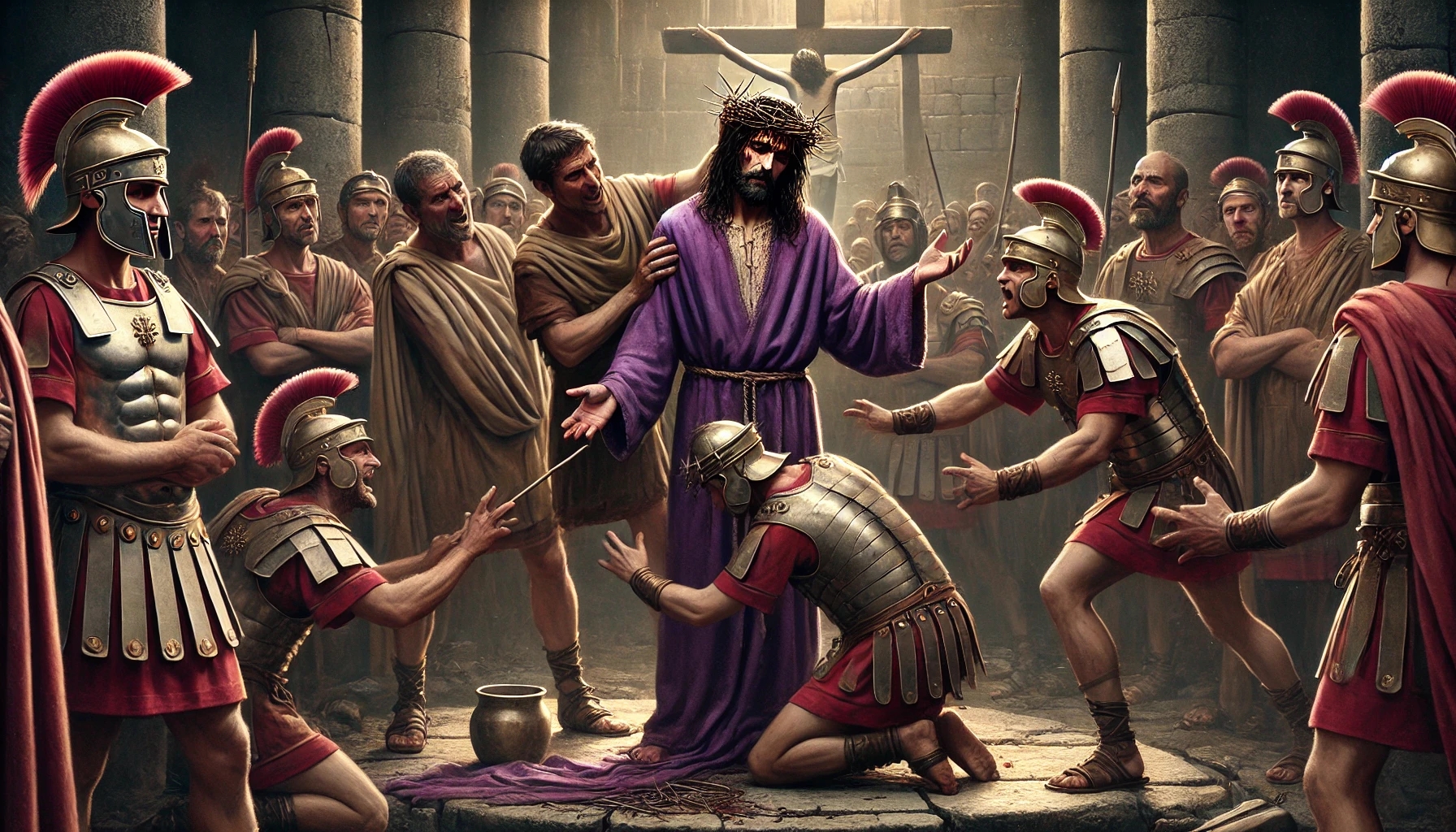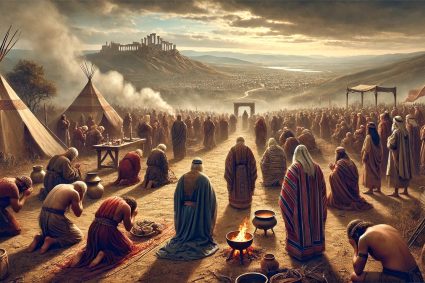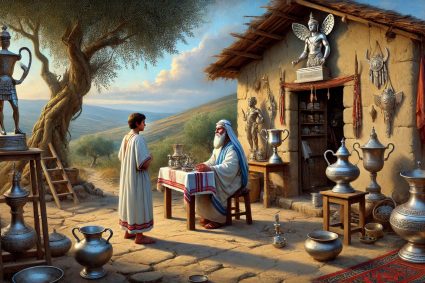
August 26, 2024
DAILY BIBLE READING – Matthew Chapter 27
1 When the morning was come, all the chief priests and elders of the people took counsel against Jesus to put him to death:
2 And when they had bound him, they led him away, and delivered him to Pontius Pilate the governor.
3 Then Judas, which had betrayed him, when he saw that he was condemned, repented himself, and brought again the thirty pieces of silver to the chief priests and elders,
4 Saying, I have sinned in that I have betrayed the innocent blood. And they said, What is that to us? see thou to that.
5 And he cast down the pieces of silver in the temple, and departed, and went and hanged himself.
6 And the chief priests took the silver pieces, and said, It is not lawful for to put them into the treasury, because it is the price of blood.
7 And they took counsel, and bought with them the potter’s field, to bury strangers in.
8 Wherefore that field was called, The field of blood, unto this day.
9 Then was fulfilled that which was spoken by Jeremy the prophet, saying, And they took the thirty pieces of silver, the price of him that was valued, whom they of the children of Israel did value;
10 And gave them for the potter’s field, as the Lord appointed me.
11 And Jesus stood before the governor: and the governor asked him, saying, Art thou the King of the Jews? And Jesus said unto him, Thou sayest.
12 And when he was accused of the chief priests and elders, he answered nothing.
13 Then said Pilate unto him, Hearest thou not how many things they witness against thee?
14 And he answered him to never a word; insomuch that the governor marvelled greatly.
15 Now at that feast the governor was wont to release unto the people a prisoner, whom they would.
16 And they had then a notable prisoner, called Barabbas.
17 Therefore when they were gathered together, Pilate said unto them, Whom will ye that I release unto you? Barabbas, or Jesus which is called Christ?
18 For he knew that for envy they had delivered him.
19 When he was set down on the judgment seat, his wife sent unto him, saying, Have thou nothing to do with that just man: for I have suffered many things this day in a dream because of him.
20 But the chief priests and elders persuaded the multitude that they should ask Barabbas, and destroy Jesus.
21 The governor answered and said unto them, Whether of the twain will ye that I release unto you? They said, Barabbas.
22 Pilate saith unto them, What shall I do then with Jesus which is called Christ? They all say unto him, Let him be crucified.
23 And the governor said, Why, what evil hath he done? But they cried out the more, saying, Let him be crucified.
24 When Pilate saw that he could prevail nothing, but that rather a tumult was made, he took water, and washed his hands before the multitude, saying, I am innocent of the blood of this just person: see ye to it.
25 Then answered all the people, and said, His blood be on us, and on our children.
26 Then released he Barabbas unto them: and when he had scourged Jesus, he delivered him to be crucified.
27 Then the soldiers of the governor took Jesus into the common hall, and gathered unto him the whole band of soldiers.
28 And they stripped him, and put on him a scarlet robe.
29 And when they had platted a crown of thorns, they put it upon his head, and a reed in his right hand: and they bowed the knee before him, and mocked him, saying, Hail, King of the Jews!
30 And they spit upon him, and took the reed, and smote him on the head.
31 And after that they had mocked him, they took the robe off from him, and put his own raiment on him, and led him away to crucify him.
32 And as they came out, they found a man of Cyrene, Simon by name: him they compelled to bear his cross.
33 And when they were come unto a place called Golgotha, that is to say, a place of a skull,
34 They gave him vinegar to drink mingled with gall: and when he had tasted thereof, he would not drink.
35 And they crucified him, and parted his garments, casting lots: that it might be fulfilled which was spoken by the prophet, They parted my garments among them, and upon my vesture did they cast lots.
36 And sitting down they watched him there;
37 And set up over his head his accusation written, This Is Jesus The King Of The Jews.
38 Then were there two thieves crucified with him, one on the right hand, and another on the left.
39 And they that passed by reviled him, wagging their heads,
40 And saying, Thou that destroyest the temple, and buildest it in three days, save thyself. If thou be the Son of God, come down from the cross.
41 Likewise also the chief priests mocking him, with the scribes and elders, said,
42 He saved others; himself he cannot save. If he be the King of Israel, let him now come down from the cross, and we will believe him.
43 He trusted in God; let him deliver him now, if he will have him: for he said, I am the Son of God.
44 The thieves also, which were crucified with him, cast the same in his teeth.
45 Now from the sixth hour there was darkness over all the land unto the ninth hour.
46 And about the ninth hour Jesus cried with a loud voice, saying, Eli, Eli, lama sabachthani? that is to say, My God, my God, why hast thou forsaken me?
47 Some of them that stood there, when they heard that, said, This man calleth for Elias.
48 And straightway one of them ran, and took a spunge, and filled it with vinegar, and put it on a reed, and gave him to drink.
49 The rest said, Let be, let us see whether Elias will come to save him.
50 Jesus, when he had cried again with a loud voice, yielded up the ghost.
51 And, behold, the veil of the temple was rent in twain from the top to the bottom; and the earth did quake, and the rocks rent;
52 And the graves were opened; and many bodies of the saints which slept arose,
53 And came out of the graves after his resurrection, and went into the holy city, and appeared unto many.
54 Now when the centurion, and they that were with him, watching Jesus, saw the earthquake, and those things that were done, they feared greatly, saying, Truly this was the Son of God.
55 And many women were there beholding afar off, which followed Jesus from Galilee, ministering unto him:
56 Among which was Mary Magdalene, and Mary the mother of James and Joses, and the mother of Zebedees children.
57 When the even was come, there came a rich man of Arimathaea, named Joseph, who also himself was Jesus’ disciple:
58 He went to Pilate, and begged the body of Jesus. Then Pilate commanded the body to be delivered.
59 And when Joseph had taken the body, he wrapped it in a clean linen cloth,
60 And laid it in his own new tomb, which he had hewn out in the rock: and he rolled a great stone to the door of the sepulchre, and departed.
61 And there was Mary Magdalene, and the other Mary, sitting over against the sepulchre.
62 Now the next day, that followed the day of the preparation, the chief priests and Pharisees came together unto Pilate,
63 Saying, Sir, we remember that that deceiver said, while he was yet alive, After three days I will rise again.
64 Command therefore that the sepulchre be made sure until the third day, lest his disciples come by night, and steal him away, and say unto the people, He is risen from the dead: so the last error shall be worse than the first.
65 Pilate said unto them, Ye have a watch: go your way, make it as sure as ye can.
66 So they went, and made the sepulchre sure, sealing the stone, and setting a watch.
King James Version. Public Domain
Commentary
Introduction:
The 27th chapter of the Gospel of Matthew describes the dramatic and fateful events leading up to the crucifixion and death of Jesus Christ. It begins with the condemnation by the chief priests and elders, the betrayal and tragic end of Judas, and culminates in the crucifixion of Jesus. This narrative not only illuminates human cruelty and failure but also the fulfillment of divine prophecies and the triumphant culmination associated with Jesus’ death.
Commentary:
Matthew 27 is a chapter filled with profound tragedy and spiritual significance, depicting the final hours of Jesus Christ’s life. It starts with the decision of the Jewish leaders to hand Jesus over to the Roman governor Pontius Pilate. This decision not only expresses their rejection of Jesus as the Messiah but also fulfills the Scriptures that predicted the course of the Passion.
Judas Iscariot, who has betrayed Jesus, is portrayed in a particularly tragic light in this chapter. Overwhelmed by guilt upon realizing that Jesus has been sentenced to death, Judas desperately returns the thirty pieces of silver and subsequently takes his own life. His actions are a stark testimony to the devastating consequences of betrayal and guilt. The chief priests, rejecting the money as “blood money,” further reveal their hypocrisy by using it to buy the Potter’s Field, which becomes a burial place for foreigners.
Jesus’ encounter with Pilate reveals the political and moral complexity of the situation. Although Pilate is convinced of Jesus’ innocence, he succumbs to the crowd’s pressure, manipulated by the chief priests, and releases Barabbas, a notorious criminal. Pilate’s symbolic act of washing his hands emphasizes his moral weakness and the inevitability of divine providence.
The cruel treatment of Jesus by the Roman soldiers, his mockery, and the crucifixion itself carry deep symbolic meaning. The purple robe and the crown of thorns placed on him are not only symbols of mockery but also symbols of his true kingship, which will only be fully revealed through the sacrifice on the cross. The crowd’s cry, “His blood be on us and on our children!” becomes a grim prophecy of Jerusalem’s destruction.
The crucifixion at Golgotha is the central moment of the chapter. Jesus’ cry, “My God, my God, why have you forsaken me?” expresses the deepest human abandonment and suffering he endures for the sins of humanity. Simultaneously, the tearing of the temple curtain, the earthquake, and the resurrection of the saints make it clear that this sacrifice transforms the divine order and paves the way for redemption.
The confession of the Roman centurion, who recognizes Jesus as “truly the Son of God,” shows that Jesus’ divine identity is acknowledged even by Gentiles. This marks the beginning of the universal claim of the Gospel, extending beyond the boundaries of Israel.
Jesus’ burial by Joseph of Arimathea, who places him in a new tomb, and the subsequent guarding of the tomb by Roman soldiers to prevent resurrection, are final human attempts to control God’s work. Yet, these efforts will prove futile in the forthcoming events.
Summary:
Matthew 27 describes the final hours of Jesus and the path to the crucifixion, marked by betrayal, hypocrisy, and divine providence. The chapter reveals human depravity but also the fulfillment of prophecies and the unstoppable power of the divine plan for the redemption of humanity. Jesus’ crucifixion, accompanied by supernatural signs and the acknowledgment of his divine sonship, marks the climax of his sacrifice and the beginning of a new era in the history of salvation.
![]()

WEEKLY SPIRIT OF PROPHECY READING – Ellen White | The Desire of Ages Chapter 58—“Lazarus, Come Forth”
This chapter is based on Luke 10:38-42; John 11:1-44.
Read online here
Commentary
The chapter “Lazarus, Come Fourth” describes one of the most powerful and symbolic episodes in the ministry of Jesus. The raising of Lazarus from the dead is not only a remarkable miracle but also a profound testament to Jesus’ divine authority and love for his friends. This chapter uniquely brings together faith, hope, and the nature of divine providence.
Lazarus and the Family in Bethany:
Lazarus, along with his sisters Mary and Martha, are among Jesus’ most devoted followers. The close bond between them and Jesus goes far beyond what one would expect in a mere teacher-student relationship. The house in Bethany, home to Lazarus and his sisters, often serves as a refuge for Jesus, a place of peace and friendship where he can rest from the demands of his public ministry. This deep emotional connection becomes particularly evident when Lazarus falls ill and eventually dies.
Jesus’ Reaction to Lazarus’ Death:
Interestingly, Jesus hesitates to go to Bethany upon hearing of Lazarus’ illness. This delay initially seems puzzling, especially to the disciples who are aware of Jesus’ deep affection for Lazarus and his family. However, Jesus’ delay is intentional and serves a greater purpose: the glorification of God and the strengthening of his disciples’ faith. Jesus knows that the forthcoming miracle, the resurrection of Lazarus, will provide a powerful demonstration of his divine power and his identity as the Messiah.
The Dialogue with Martha and Mary:
When Jesus finally arrives in Bethany, he is greeted by Martha, who affirms her faith in him but is still sorrowful over her brother’s death. Jesus uses this moment to strengthen both Martha’s and Mary’s faith by telling them that he himself is “the resurrection and the life.” These words are central, as they not only point to the imminent resurrection of Lazarus but also to the deeper truth that Jesus embodies eternal life itself.
The Raising of Lazarus:
The climax of the chapter is undoubtedly the scene where Jesus calls Lazarus out of the tomb. This act is so powerful and majestic that it dispels any doubts about Jesus’ divine nature. The miracle is a symbolic act that foreshadows the future resurrection of all believers and demonstrates Jesus’ sovereignty over life and death. The reaction of those present—a mixture of astonishment, joy, and gratitude—highlights the profound emotional and spiritual impact of this miracle.
Significance for Faith:
The raising of Lazarus is not only a physical miracle but also a spiritual sign. It shows that faith in Jesus offers a living hope for eternal life, a hope that extends beyond death. Jesus demonstrates that death does not have the final word, but that through him, life triumphs. For the disciples and all who witness this event, it becomes clear that Jesus is indeed the Son of God, who has come to establish the Kingdom of God on earth.
The Deep Humanity of Jesus:
What is particularly moving is the portrayal of Jesus’ deep compassion. Although he knows that he will raise Lazarus from the dead, he weeps with those who mourn. These tears reveal Jesus’ full humanity and his capacity to experience genuine pain and loss. It presents a picture of Jesus that brings him closer to us: the divine Savior who is fully human, suffering with us and understanding our suffering.
Conclusion:
The chapter “Lazarus, Come Fourth” illustrates that Jesus’ actions and words are always directed toward a deeper, divine purpose—revealing his nature and mission to bring life that transcends death. The resurrection of Lazarus is a precursor to the final resurrection and a powerful symbol of the victory of life over death. It reminds us that in times of suffering and darkness, faith in Christ can lead us to a new life that surpasses our current reality.
Visited 111 times, 1 visit(s) today






